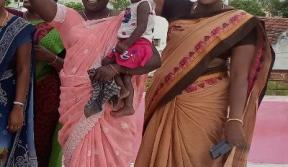Mark’s Work Wearhouse explains that they conduct “social compliance audits, mainly with our partner Bureau Veritas (BV), based on BV's audit standards, which follow the International Labour Organizations (ILO) base standards.”
H&M boasts: “Since 2005 H&M has been an accredited company in the Fair Labor Association (FLA). … Our participation in the FLA is a way of demonstrating to our stakeholders how well our follow-up work in the factories is working. … We also use the results from the FLA’s audits as a benchmark in order to ensure the quality of our internal monitoring program.”
Yet, one may wonder if fires have now become part of apparel companies’ business equation for Bangladesh. In the aftermath of Thursday’s fire, The Daily Star published this (incomplete) list of recent garment factory fires in Bangladesh:
- 62 killed at KTS Garments, Chittagong 2006
- 32 killed at Saraka Garments, Dhaka 1990
- 24 killed at Shanghai Apparels, Dhaka 1997
- 23 killed at Macro Sweater, Dhaka 2000
- 23 killed at Chowdhury Knitwear, Narsingdi 2004
- 23 killed at Shan Knitting, Narayanganj 2005
- 22 killed at Lusaka Garments, Dhaka 1996
- 20 killed at Jahanara Fashion, Narayanganj 1997
- 12 killed at Globe Knitting, Dhaka 2000
The Daily Star reminds its readers that just six months ago a fire broke out at the very same factory, Garib & Garib, killing a fire fighter. “Locals and firefighters said the owners do not seem to have learned much from the fire in the same building six months back,” the paper reports. Nor have the apparel brands. All their factory audits seemingly could not prevent another tragedy.
Factory fires in Bangladesh are the predictable outcome of the lethal “low-price-at-any-cost” business model that ignites a race to the bottom in which Bangladesh is one of the victors, claiming “ground zero” in working conditions. More than 4,000 factories and two millions workers in Bangladesh now toil at ground zero at a terrible cost to human lives.
In the aftermath of the fire, the apparel brands and others will investigate and discussion will focus on faulty equipment, lack of training and fire-drills, and perhaps there will be concerns raised about locked exits and poor ventilation. But there are bigger questions that must not be missed:
- Why do factory audits fail to prevent fires? Why are the fires so common?
- Why do we allow workers in Bangladesh to subsidize the cost of clothing we buy? How much do they pay—in poor working and living conditions—for every item of cheap clothing we buy?
- Why does the garment sector in Bangladesh continue to grow despite the fires and despite the abusive working conditions that nobody—not even the brands themselves—deny?
- Why were workers still in the factory at 10 p.m.? Why were they locked in?
Until we ask such questions—and get honest answers—garment factories will continue to burn and workers will die. Garib & Garib reportedly will be open for business again as soon as this Tuesday, just five days after the fire, the list of dead workers now just a hazy blur, a temporary interruption and an acceptable cost of business. According to a company director, the factory is “fully compliant.”

Comments
re: Twenty-one Locked-In Apparel Workers Die in another Factory
I would like to express ILRFs solidarity in standing with the survivors of this horrible tragedy. We will continue to fight with those in Bangladesh for a more just workplace.
re: Twenty-one Locked-In Apparel Workers Die in another Factory
I am utterly horrified at the fire in Bangladesh. I hope that no Irish brands or retailers are supplied by the factory.
re: Twenty-one Locked-In Apparel Workers Die in another Factory
Oh my god so high death toll, world would take nitice of human rights in Bangladeh
http://healthbodyfit.com
re: Twenty-one Locked-In Apparel Workers Die in another Factory
Wow...we so often take work for granted and even despise it everyday. How bout losing your life at work, or losing your wife at work? They will surely be in my prayers...